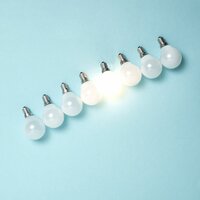Switching from halogen to LED lighting has become increasingly common in recent years. This is not only due to the long lifespan and energy efficiency of LED lighting but also because the technology has improved significantly, allowing LED bulbs to match the brightness and color spectrum of halogen lamps. In this blog, we’ll discuss why replacing halogen with LED is a smart choice and take a closer look at specific applications such as halogen spots, LED halogen, and halogen dimmers.
Halogen spots are a popular lighting choice in both residential and commercial settings. They provide bright, crisp light and are often used in kitchens, bathrooms, living rooms, or as accent lighting. However, halogen bulbs are less energy-efficient than modern LED bulbs and have a shorter lifespan. This means you'll need to replace the bulbs more frequently, leading to higher electricity costs.
By replacing a halogen spot with an LED spot, you're not only making a move toward energy efficiency but also saving money in the long run. LED spots use significantly less energy than halogen spots and last much longer—some LED bulbs can last up to 25,000 hours, while halogen bulbs typically last only 2,000 hours. This means fewer replacements and even lower costs.
Moreover, LED spots are now available in a wide range of shapes and light colors, so you can customize the lighting to suit your specific needs without compromising on light quality.
Many people choose to replace their halogen lighting with LED halogen lamps. These are LED bulbs designed to mimic the shape and appearance of traditional halogen lamps but with all the advantages of LED technology. LED halogen offers the same brightness and light quality as traditional halogen lamps but uses far less energy.
A major benefit of LED halogen is that it often provides a direct replacement for halogen bulbs in existing fixtures. This makes the transition simple, without the need to rework your entire lighting setup. Additionally, many LED halogen bulbs are dimmable, allowing you to create the desired ambiance without sacrificing energy savings.
LED halogen is not only more energy-efficient but also more environmentally friendly. Unlike some other lighting technologies, LED bulbs do not contain harmful substances like mercury, making them a more sustainable choice.
A common issue when transitioning from halogen to LED lighting is compatibility with dimmers. Halogen bulbs work great with dimmers, but not all dimmers are suitable for LED bulbs. You may find that your halogen dimmer doesn't work properly with LED lights, causing flickering or no dimming at all.
Fortunately, there are now special LED dimmers designed to work seamlessly with LED lighting. These dimmers allow you to adjust the light intensity as desired without encountering issues. If your halogen dimmer doesn’t work well with LEDs, you might consider replacing it with a dimmer specifically designed for LED lights.
Another advantage of replacing halogen with LED is that LED bulbs generate less heat. This not only makes them safer but also reduces the strain on the dimmer, extending the lifespan of both your lighting and dimmer.
Replacing halogen with LED is a smart choice that saves both energy and costs. LED offers numerous benefits, including a longer lifespan, lower energy bills, and a smaller environmental footprint. Whether you’re replacing halogen spots, opting for LED halogen, or dealing with dimmer compatibility issues, there are now plenty of solutions that make the transition to LED easy. It’s the future of lighting, offering the perfect combination of efficiency, performance, and sustainability.
No comments found.
